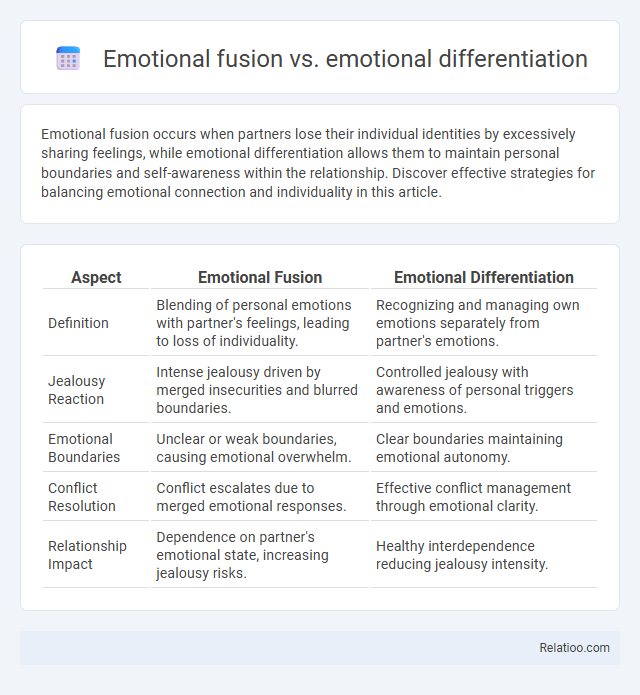Emotional fusion occurs when partners lose their individual identities by excessively sharing feelings, while emotional differentiation allows them to maintain personal boundaries and self-awareness within the relationship. Discover effective strategies for balancing emotional connection and individuality in this article.
Table of Comparison
| Aspect | Emotional Fusion | Emotional Differentiation |
|---|---|---|
| Definition | Blending of personal emotions with partner's feelings, leading to loss of individuality. | Recognizing and managing own emotions separately from partner's emotions. |
| Jealousy Reaction | Intense jealousy driven by merged insecurities and blurred boundaries. | Controlled jealousy with awareness of personal triggers and emotions. |
| Emotional Boundaries | Unclear or weak boundaries, causing emotional overwhelm. | Clear boundaries maintaining emotional autonomy. |
| Conflict Resolution | Conflict escalates due to merged emotional responses. | Effective conflict management through emotional clarity. |
| Relationship Impact | Dependence on partner's emotional state, increasing jealousy risks. | Healthy interdependence reducing jealousy intensity. |
Understanding Emotional Fusion and Emotional Differentiation
Understanding emotional fusion involves recognizing when you experience blurred boundaries between your feelings and those of others, leading to overly entangled emotional experiences. Emotional differentiation, by contrast, is the ability to identify and distinguish your own emotions from others', allowing for clearer self-awareness and healthier emotional responses. Cultivating emotional differentiation helps you maintain autonomy while engaging empathetically, preventing overwhelming emotional fusion.
The Psychology Behind Emotional Fusion
Emotional fusion occurs when Your feelings and thoughts become intertwined with someone else's, making it difficult to maintain a separate emotional identity. In contrast, emotional differentiation allows individuals to recognize and manage their own emotions independently while still connecting empathetically with others. The psychology behind emotional fusion highlights how overly enmeshed emotional boundaries can hinder personal growth and lead to heightened anxiety or dependency in relationships.
Key Characteristics of Emotional Differentiation
Emotional differentiation refers to the ability to identify and understand distinct emotions within yourself, allowing for nuanced emotional awareness and regulation. Unlike emotional fusion, where feelings are blended and overwhelming, emotional differentiation helps You recognize specific emotions, promoting healthier responses and interpersonal relationships. Key characteristics include clarity in emotional experiences, enhanced self-awareness, and the capacity to manage complex feelings effectively.
Signs You May Be Experiencing Emotional Fusion
Emotional fusion occurs when your feelings are so intertwined with another person's emotions that you struggle to maintain emotional independence, leading to blurred boundaries and increased anxiety or stress. Signs you may be experiencing emotional fusion include difficulty distinguishing your own emotions from someone else's, constant need for reassurance, and feeling overwhelmed by the emotional states of those close to you. Emotional differentiation, by contrast, allows you to recognize and manage your own emotions separately, promoting healthier relationships and personal well-being.
Benefits of Emotional Differentiation in Relationships
Emotional differentiation enhances your ability to recognize and manage complex feelings, leading to healthier communication and reduced conflict in relationships. By maintaining a clear sense of self while staying emotionally connected, partners experience greater intimacy and mutual respect. This skill fosters resilience, allowing you to navigate challenges without becoming overwhelmed or overly dependent on your partner's emotions.
Emotional Fusion: Roots and Causes
Emotional fusion occurs when individuals lose their sense of self within close relationships, leading to blurred boundaries and intertwined emotional experiences. Rooted in early family dynamics, emotional fusion often stems from unmet attachment needs and enmeshment, where personal feelings become indistinguishable from those of others. Understanding your emotional fusion helps in recognizing patterns that hinder autonomy and fosters healthier emotional boundaries.
Strategies to Foster Emotional Differentiation
Emotional differentiation involves recognizing and labeling distinct emotions to enhance self-awareness and emotional regulation, unlike emotional fusion, where individuals struggle to separate their feelings from others. Strategies to foster emotional differentiation include practicing mindfulness to observe emotions without judgment, journaling to articulate specific feelings, and developing emotional vocabulary through therapy or targeted exercises. Encouraging reflective dialogue and emotional coaching can further support individuals in distinguishing between complex emotional states and responding adaptively.
Emotional Fusion vs. Differentiation: Impact on Mental Health
Emotional fusion occurs when individuals struggle to separate their feelings from others, often leading to heightened anxiety, stress, and impaired decision-making, whereas emotional differentiation allows for clear recognition and management of personal emotions, promoting resilience and mental clarity. Your ability to develop emotional differentiation is crucial for reducing emotional reactivity and improving overall psychological well-being. Mental health benefits significantly from maintaining emotional boundaries, as fusion tends to exacerbate symptoms of depression and anxiety by blurring emotional experiences.
Navigating Conflict: Fusion versus Differentiation Approaches
Navigating conflict in relationships involves understanding emotional fusion and emotional differentiation, two contrasting approaches that influence interpersonal dynamics. Emotional fusion occurs when partners' feelings and identities become intertwined, often leading to blurred boundaries and heightened conflict due to over-dependence and lack of individual autonomy. Emotional differentiation promotes healthy boundaries by encouraging individuals to maintain their distinct emotional experiences, fostering open communication and effective conflict resolution through balanced self-regulation and empathy.
Building Healthy Relationships Through Differentiation
Building healthy relationships through emotional differentiation involves recognizing and respecting individual emotions while maintaining personal identity within the connection. Emotional fusion blurs personal boundaries, leading to codependency and reduced autonomy, whereas emotional differentiation allows partners to engage authentically without losing selfhood. Prioritizing differentiation fosters open communication, emotional regulation, and mutual growth, essential for sustainable and balanced relationships.

Infographic: Emotional fusion vs Emotional differentiation
 relatioo.com
relatioo.com